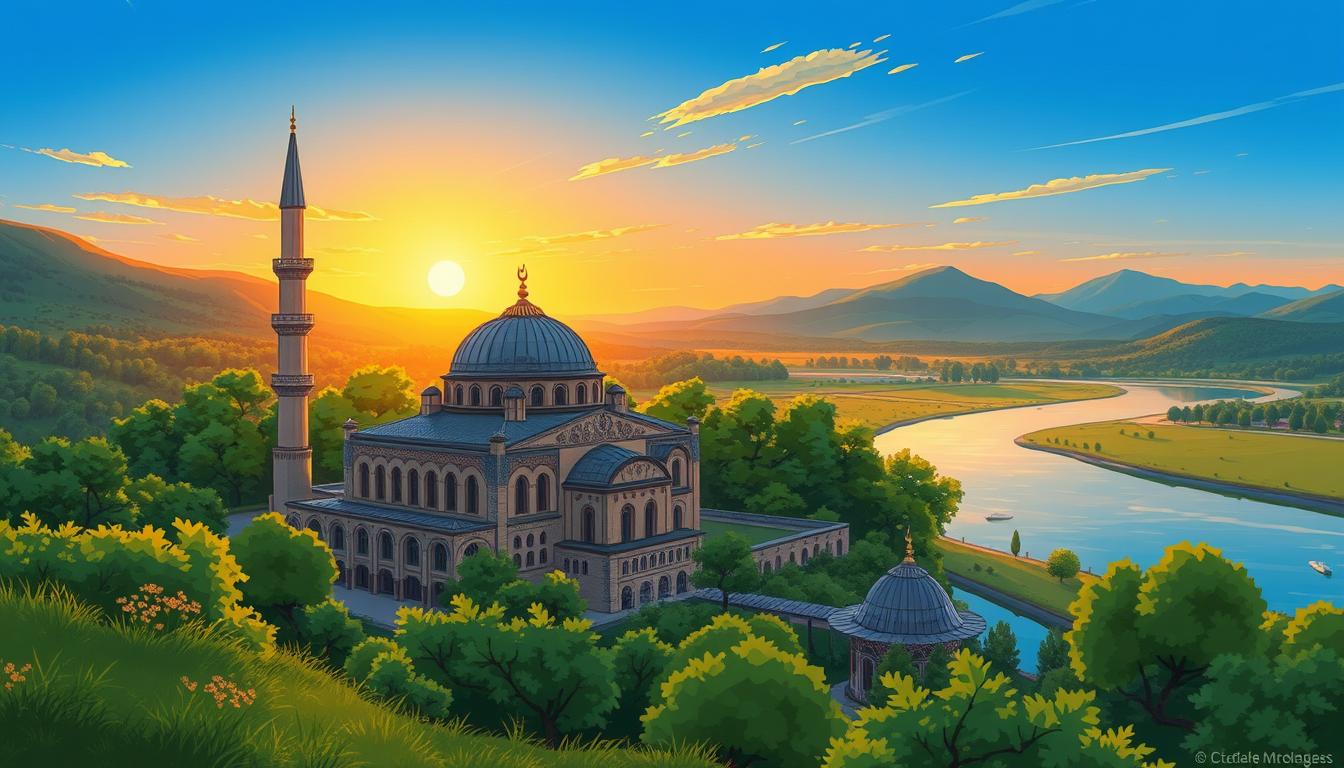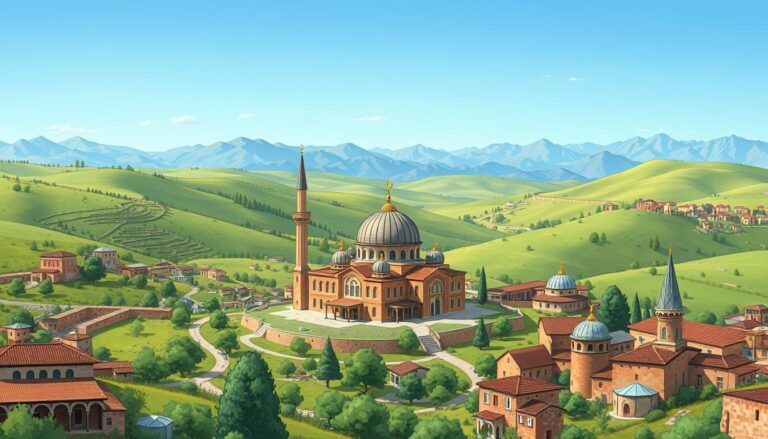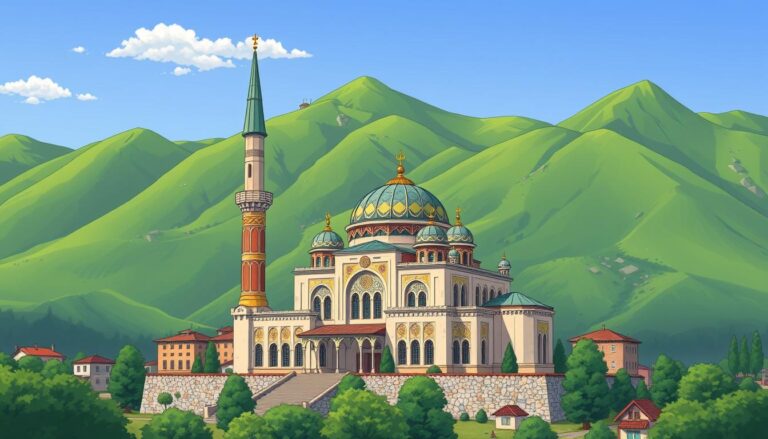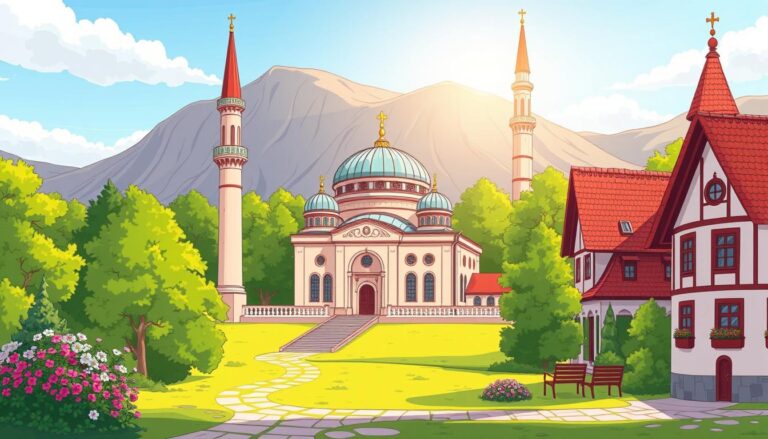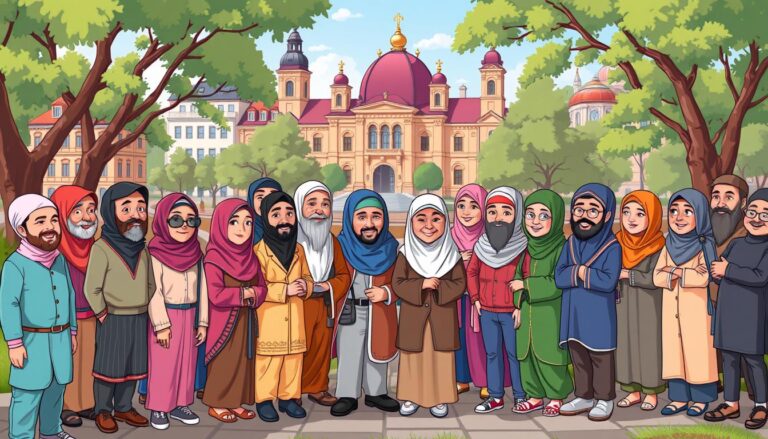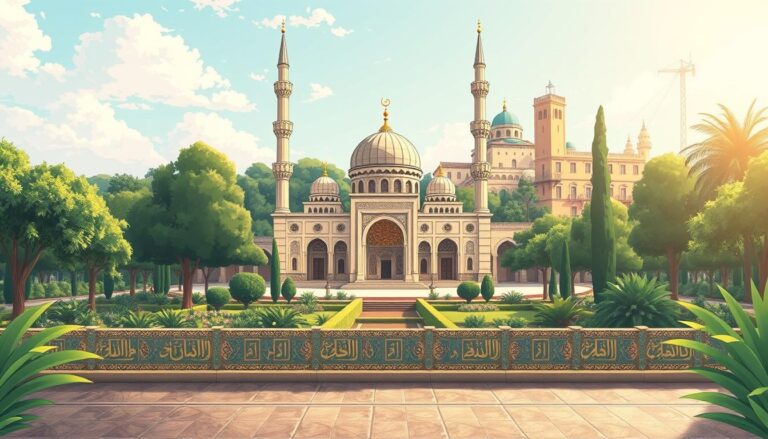Islam in Serbia
According to the 2022 census, there were 278,212 Muslims in Serbia, making up 4.2% of the total population. This surprising statistic highlights the significant presence of Islam in a country known for its predominantly Christian Orthodox heritage. The largest concentration of Muslims can be found in the Sandžak region in southwestern Serbia, as well as in the Preševo Valley in the country’s south. Islam’s history in Serbia dates back to the three centuries of Ottoman rule in the Balkans, and despite Serbia’s Christian majority, the faith has maintained a strong foothold in the country for centuries.
Key Takeaways
- Serbia has a Muslim population of around 4.2% of the total population, according to the 2022 census.
- The largest concentration of Muslims is in the Sandžak region and the Preševo Valley.
- Islam has a long history in Serbia, dating back to the Ottoman rule in the Balkans.
- The Muslim population in Serbia consists primarily of Bosniaks, Albanians, and Muslim Roma.
- Islam has maintained a presence in Serbia despite the country’s predominantly Christian Orthodox heritage.
Demographics of Islam in Serbia
According to the 2022 census in Serbia, the Muslim population stands at 278,212, making up 4.2% of the total population. The largest concentration of Muslims can be found in the southwestern regions, particularly the Sandžak area, which includes the municipalities of Novi Pazar, Tutin, Sjenica, and Prijepolje.
Muslim Population Statistics
The municipality of Novi Pazar is home to Serbia’s largest Muslim population, with 82,710 Muslims out of a total of 100,410 inhabitants (82% of the population). The municipality of Tutin has the highest percentage of Muslims in Serbia, with around 94% of its population being Muslim. The Sjenica Municipality also has a very large Muslim population (79%), followed by the Prijepolje Municipality (45%).
Geographical Distribution of Muslims
Most Albanians, who are predominantly Muslim, live in the municipalities of Preševo, Bujanovac, and Medveđa. While many of them boycotted the 2011 census, statistics from the 2002 census show that Muslims constitute a majority in those municipalities, with 89%, 55%, and 29% respectively.
The Muslim population in Serbia has seen an increase over the years, growing from 2.23% in 1921 to 4.19% in 2011 and further to 4.2% in the latest 2022 census. This growth reflects the demographic shifts and the changing religious landscape in the country.
“The Muslim population in Serbia represents around 4.2% of the total population based on the 2022 census data.”
History of Islam in Serbia
Islam’s presence in Serbia can be traced back to the centuries of Ottoman rule in the Balkans. During this period, the Muslim population in Serbia consisted primarily of ethnic Bosniaks, Albanians, and a significant portion of Muslim Roma, as well as members of smaller groups like ethnic Muslims and Gorani. Some Serbs also converted to Islam, with the renowned Mehmed Pasha Sokolović, also known as Meša Selimović, being one of the most well-known Muslim Serbs.
Today, Islam is predominantly found in the southwestern regions of Serbia, particularly in the Sandžak and Raška areas, as well as parts of southern Serbia, where the majority of the Muslim population resides. According to the 2022 census, Serbia has a Muslim population representing around 4.2% of the total population, with the largest concentration in Novi Pazar, where Muslims make up 82.9% of the local population.
The history of Islam in Serbia is closely intertwined with the Ottoman rule in Serbia and the spread of Islam in Serbia during that era. The Islamic influence in Serbia can be seen in the architectural and cultural legacy left behind by the Ottoman presence, which continues to shape the country’s diverse religious landscape.
“Serbia has a Muslim population representing around 4.2% of the total population, according to the 2022 census.”
The presence of Islam in Serbia has evolved over time, with the Muslim population experiencing both growth and decline throughout the country’s history. The relationship between the Muslim community and the Serbian Orthodox majority has often been complex, with periods of coexistence and tension. Understanding the history of Islam in Serbia is crucial in appreciating the country’s rich cultural diversity and the role of Islam in shaping its social and political landscape.
Ethnic Muslim Groups in Serbia
The diverse Muslim population in Serbia consists primarily of Bosniaks, Albanians, and Muslim Roma, as well as smaller communities like the Gorani. These ethnic Muslim groups have their unique histories, cultural traditions, and roles within the Serbian societal fabric.
Bosniaks and Ethnic Muslims
Bosniaks and ethnic Muslims make up the largest Muslim ethnic group in Serbia, predominantly residing in the Sandžak region. With a total population of 153,801, Bosniaks represent 2.31% of Serbia’s total population. The Bosniak-majority towns of Novi Pazar, Tutin, and Sjenica serve as cultural and political hubs for this community.
The majority of Bosniaks in Serbia are Sunni Muslims following the Hanafi school of thought. Despite facing challenges like emigration and maintaining their distinct identity, the Bosniak community remains a vibrant and influential part of the Serbian Muslim landscape.
Albanians
Ethnic Albanians, who adhere to the Islamic faith, primarily reside in the Preševo Valley region of southern Serbia. As a sizable Muslim minority, Albanians in Serbia have navigated complex social and political dynamics, often seeking greater autonomy and representation.
Muslim Roma
The Muslim Roma community in Serbia includes Balkan Romani-speaking groups and Serbian-speaking groups, as well as Albanian-speaking Roma. These diverse Muslim Roma populations are found across southern Serbia, contributing to the rich tapestry of the country’s Muslim heritage.
Gorani
The Gorani, a Slavic ethnic group, constitute another Muslim community present in Serbia. The Gorani are primarily concentrated in the Gora region, near the borders with Kosovo and North Macedonia, maintaining their distinct cultural and linguistic identity within the Serbian Muslim landscape.
These ethnic Muslim groups, each with their unique histories and traditions, collectively shape the diversity and vibrancy of the Muslim communities in Serbia.
Islamic Organizations and Leadership
The Muslim faithful in the Republic of Serbia, comprising 3.2% of the population or 239,658 people, are organized into two distinct entities: the Islamic Community in Serbia and the Islamic Community of Serbia. These organizations play a crucial role in shaping the Islamic landscape and leadership within the country.
Islamic Community of Serbia
The Islamic Community of Serbia, headquartered in Belgrade, is administered by Reis-ul-ulema Sead Nasufović. This organization includes the Mešihat of Serbia, the Mešihat of Raška, and the Mešihat of Preševo, reflecting its comprehensive reach across the nation’s Muslim communities.
Islamic Community in Serbia
Parallel to the Islamic Community of Serbia, the Islamic Community in Serbia, led by Mufti Mevlud Dudić, is centered in Novi Pazar. This entity oversees the Islamic Community in the Sandžak region, the Islamic Community in Vojvodina, the Islamic Community in Preševo Valley, and the Islamic Community in Central Serbia.
The financial support allocated by the Ministry of Religious Affairs in Serbia has favored the Islamic Community of Bosnia-Herzegovina Riyasat, which received 67% of the total grants in 2008 and 60% in the first half of 2009. In comparison, the Islamic Community of Serbia received 33% of the grants in 2008 and 40% in the first half of 2009.
“The perception of Muslims in Serbia has been influenced by historical narratives and oral storytelling traditions.”
Despite the challenges faced by Muslim communities in Serbia, the dedicated efforts of Islamic organizations and their leadership continue to shape the religious and cultural landscape of the nation.
Islam in Serbia
Islam has a long and significant presence in Serbia, dating back to the arrival of the Ottoman Empire in the 14th century. During this period, some Serbs converted to Islam, particularly in the region of Ottoman Bosnia. Today, Islam is predominantly found in southwestern Serbia, in the regions of Sandžak and Raška, as well as in parts of southern Serbia, where the majority of the Muslim population resides.
According to the 2022 census, the Muslim population in Serbia accounts for around 4.2% of the total population, with an estimated 278,212 adherents of the Islamic faith. The municipality of Novi Pazar holds the largest Muslim population in the country, with 82,710 Muslims out of a total population of 100,410 inhabitants.
The Islamic influence in Serbia is further evident in the presence of two distinct Islamic communities: the Islamic Community of Serbia and the Islamic Community in Serbia. These organizations play a crucial role in the religious and cultural life of the Muslim population, ensuring the preservation of Islamic traditions and practices.
“Islam has maintained a significant presence in Serbia for centuries, contributing to the country’s rich cultural and religious diversity.”
While Serbia is predominantly a Christian country, the role of Islam in Serbian society remains an integral part of the nation’s history and identity. The Muslim population, comprised of diverse ethnic groups such as Bosniaks, Albanians, and Roma, continues to shape the social and cultural landscape of the country.
Islamic Culture and Practices
Islamic culture and practices have had a significant influence in Serbia, particularly in the regions with a higher concentration of Muslim population. The country is home to numerous mosques, showcasing the rich Islamic architecture in Serbia. The Bajrakli Mosque in Belgrade stands as one of the most notable examples, with its distinctive architectural style and historical significance.
Beyond the mosques, Muslim cultural practices in Serbia are deeply rooted in the daily lives of the communities. Islamic traditions and customs in Serbia, such as religious festivals, dietary restrictions, and other cultural practices, are integral to the faith and way of life of the Muslim population.
Mosques and Islamic Architecture
Serbia’s mosques are more than just places of worship; they are architectural marvels that reflect the Islamic culture in Serbia. The intricate designs, featuring domes, minarets, and ornate interiors, are a testament to the skilled craftsmanship and artistic expression of the Muslim community. These mosques serve as hubs for Muslim cultural practices in Serbia, where traditions and customs are preserved and celebrated.
Islamic Traditions and Customs
The Muslim communities in Serbia maintain a rich tapestry of Islamic traditions and customs. Religious festivals, such as Eid al-Fitr and Eid al-Adha, are marked with fervent celebrations, gathering families and friends to share in the joy of their faith. Dietary restrictions, like the observance of Ramadan, are also strictly followed, showcasing the devotion of the Islamic culture in Serbia.
These cultural practices not only preserve the Muslim cultural practices in Serbia but also serve as a unifying force, strengthening the sense of community and identity within the Muslim population.
Challenges and Issues Faced by Muslims
While Serbia generally provides for religious freedom, Muslim communities in the country have faced some notable challenges and issues. One of the primary concerns has been the ongoing disputes between the two main Islamic organizations in Serbia, the Islamic Community of Serbia and the Islamic Community in Serbia. This lack of unity has created difficulties in coordinating property restitution claims and selecting instructors for religion courses in public schools.
Smaller religious groups, including some Protestant denominations, have also reported continued public distrust and misunderstanding, with some being labeled as “sects.” Additionally, there have been reports of occasional incidents of vandalism and antisemitic literature targeting religious minorities in the country.
The OSCE recognized the danger of growing public intolerance against Muslims as early as 2002, and subsequent events and initiatives have sought to address this issue. In 2017, a conference held in Vienna explored current manifestations of intolerance and discrimination against Muslims, while the ODIHR has worked with OSCE participating States to develop educational policies to fight hostility and prejudice against Muslims.
“Many Muslims face discrimination in employment, housing, health care, and education.”
Hate crimes and hate-motivated incidents against Muslims are monitored through the collection of data for ODIHR’s annual Hate Crime Reporting. Recommendations for action against intolerance towards Muslims are identified in international and regional forums, and OSCE participating States are committed to combating intolerance against Muslims, strongly rejecting any association between religion or culture and terrorism.
Despite these efforts, the integration of Muslim communities into Serbian society remains a complex and ongoing challenge. The legacy of the civil war in the former Yugoslavia, as well as the influx of displaced individuals from Bosnia and Herzegovina, Croatia, and Kosovo, has contributed to the need for greater understanding and acceptance of diverse religious and ethnic groups within the country.
Interfaith Relations and Tolerance
In Serbia, interfaith relations and religious tolerance are crucial aspects of the country’s social fabric. While the government generally provides for religious freedom and promotes diversity, there have been some challenges in maintaining a harmonious relationship between the various religious groups.
Relationship with Other Religious Groups
Serbia is home to a diverse population, with the Serbian Orthodox Church being the predominant religious affiliation. However, the country also has a significant Muslim minority, as well as adherents of other faiths such as Catholicism, Protestantism, and Judaism. The government has been generally tolerant of these religious groups, allowing for the teaching of religion in public schools and the celebration of religious festivals.
Despite this, some religious leaders have reported that the government tends to favor the Serbian Orthodox Church over other religious communities. This is exemplified by the government’s financial support for the completion of an Orthodox cathedral, while not making similar grants to other religious organizations. Nevertheless, the country generally maintains a relatively tolerant relationship between its diverse religious groups, with only occasional incidents of tension or conflict.
According to research,
“In Bosnia-Herzegovina, Muslims made up about 45% of the population in 2010, slightly less than Christians at 52%. Among Bosnian Muslims, 51% say they know ‘some’ or ‘a great deal’ about Christian beliefs and practices, and 59% believe Islam and Christianity have a lot in common.”
This suggests a relatively positive level of interfaith understanding and dialogue in the region.
However, the same research also indicates that only 18% of Muslims in Bosnia-Herzegovina say they attend interfaith meetings, and less than one-in-five are comfortable with the idea of their son or daughter marrying a Christian. This highlights the need for continued efforts to promote interfaith relations and religious tolerance in Serbia and the broader Balkan region.
- Serbia generally provides for religious freedom and promotes religious diversity and tolerance.
- The government allows for the teaching of religion in public schools and the celebration of religious festivals.
- Some religious leaders have reported that the government tends to favor the Serbian Orthodox Church over other religious groups.
- Overall, the country maintains a relatively tolerant relationship between its diverse religious groups, with only occasional incidents of tension or conflict.
Conclusion
The story of Islam in Serbia is one of resilience, diversity, and coexistence. With a Muslim population comprising around 4.2% of the country’s total, Serbia has provided a relatively tolerant environment for the practice of Islam, despite occasional challenges and disputes.
The Muslim community in Serbia is a tapestry of different ethnic groups, including Bosniaks, Albanians, and Muslim Roma, as well as smaller populations like the Gorani and Serbs (Čitaci). This diversity has contributed to the richness of Serbia’s religious and cultural landscape.
While Serbia is predominantly Christian, the country has generally upheld principles of religious freedom and allowed for the maintenance of Islamic traditions and practices. However, there have been some instances of religious intolerance and ongoing tensions between Islamic organizations, which serve as a reminder of the need for continued efforts towards interfaith dialogue and mutual understanding.
In summary, the conclusion on Islam in Serbia is one of a complex and evolving relationship, where the Muslim community has carved out a place for itself within the country’s broader religious and cultural fabric. The key takeaways on Islam in Serbia are the diversity of the Muslim population, the generally tolerant environment, and the occasional challenges that still need to be addressed.
“Islam in Serbia has long been a part of the country’s religious and cultural tapestry, contributing to its rich diversity and coexistence of faiths.”
As Serbia continues to navigate the summary of Islam in Serbia, it is essential to promote interfaith cooperation, foster mutual understanding, and ensure the rights and well-being of all religious communities within the country.
Recommendations
To further improve religious freedom and tolerance in Serbia, the government could consider the following recommendations: work to resolve the disputes between the two main Islamic organizations in the country, ensuring the Muslim community has a unified voice in dealing with the government. Additionally, the government should provide equal funding and support to all registered religious groups, rather than favoring the Serbian Orthodox Church over other faiths.
Moreover, educational initiatives to promote understanding and acceptance of religious diversity, particularly towards smaller or “nontraditional” religious groups, should be developed. The government should also enhance efforts to prevent and address incidents of religious intolerance, vandalism, and hate speech targeting religious minorities.
Finally, the government should encourage and facilitate regular interfaith dialogues and events to foster greater cooperation and understanding between the country’s diverse religious communities. By implementing these measures, Serbia can continue to uphold its commitment to religious freedom and create a more inclusive, tolerant, and harmonious society for people of all faiths.
Source Links
- Islam in Serbia
- Serbia – United States Department of State
- Serb Muslims
- Religion in Serbia
- demographic situation, languages and religions
- Serbia – United States Department of State
- Religion in Serbia
- The Emigration of Muslims from the New Serbian Regions 1877/1878
- Bosniaks of Serbia
- No title found
- Being a Muslim in Belgrade. Ivan Ejub Kostić in Conversation with Armina Galijaš
- Welcome … Culture and Religion
- The Islam of the Balkans, an unknown galaxy
- The Arab Betrayal of Balkan Islam
- Countering discrimination against Muslims
- Religion and Forced Displacement in Serbia – The Foreign Policy Centre
- Tolerance and Coercion in Islam
- How Bosnian Muslims view Christians 20 years after Srebrenica massacre
- Exodus of Muslims from Serbia (1862)
- Serbia – United States Department of State
- Bosnian War | Facts, Summary, Combatants, & War Crimes

